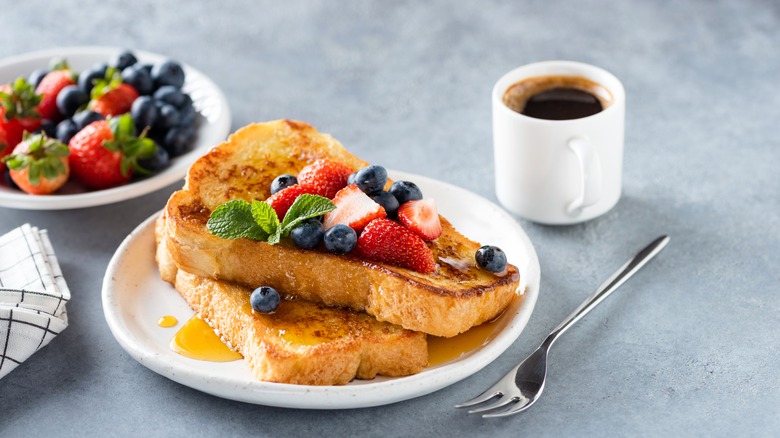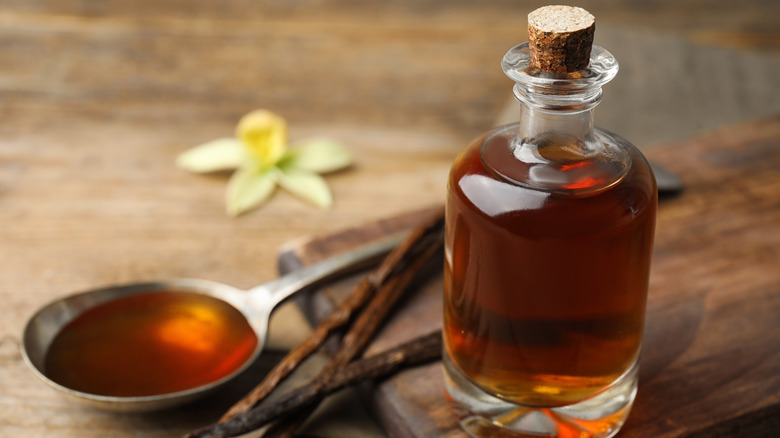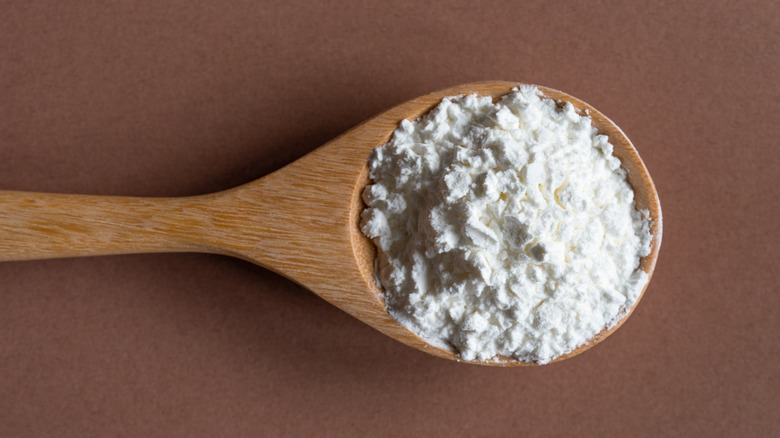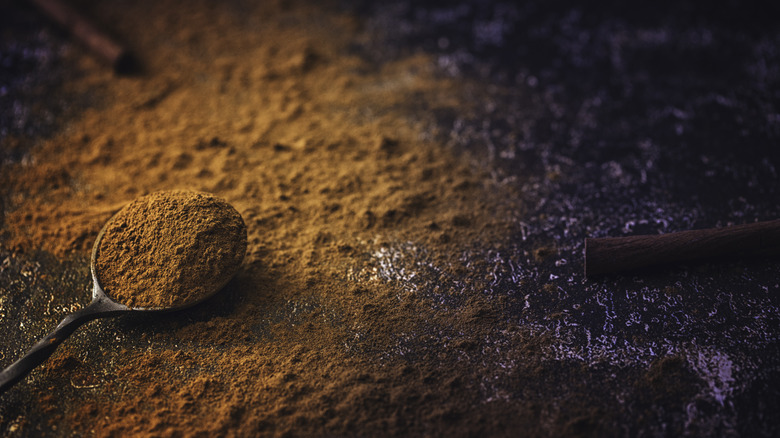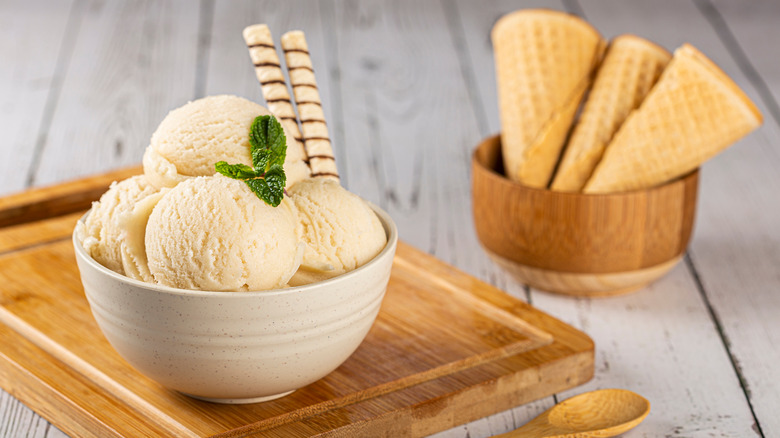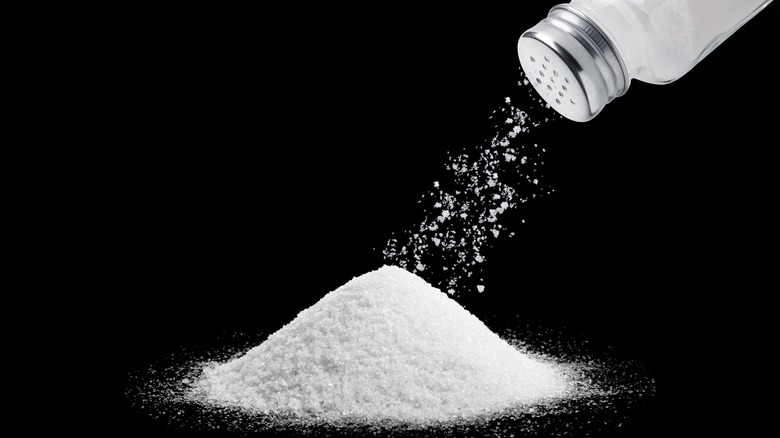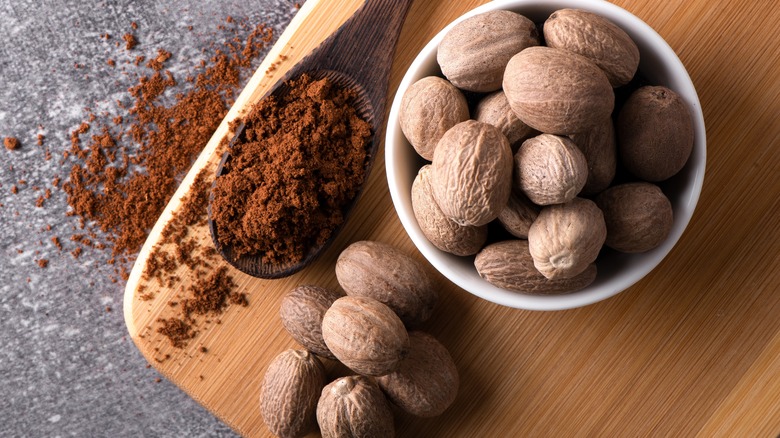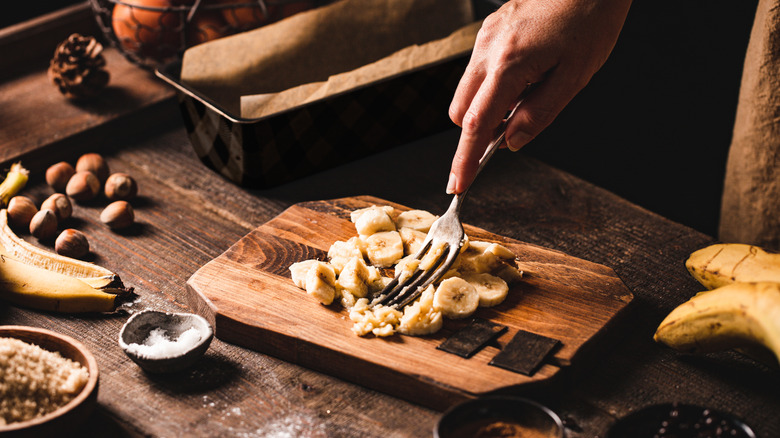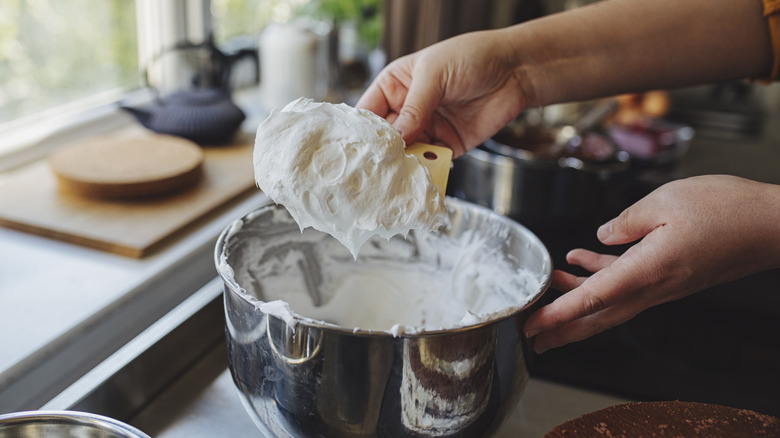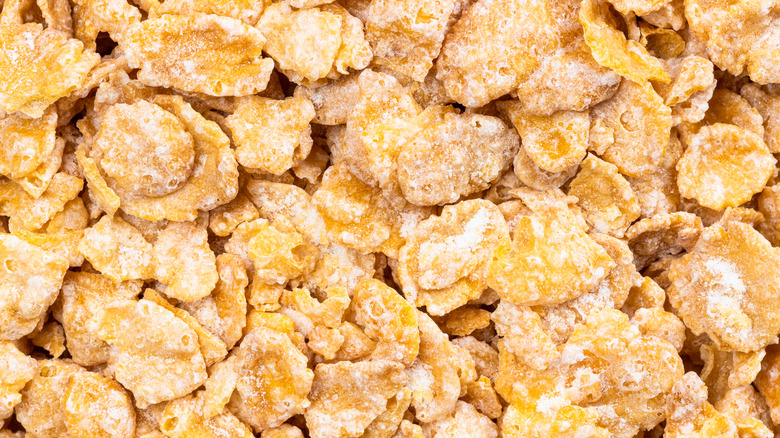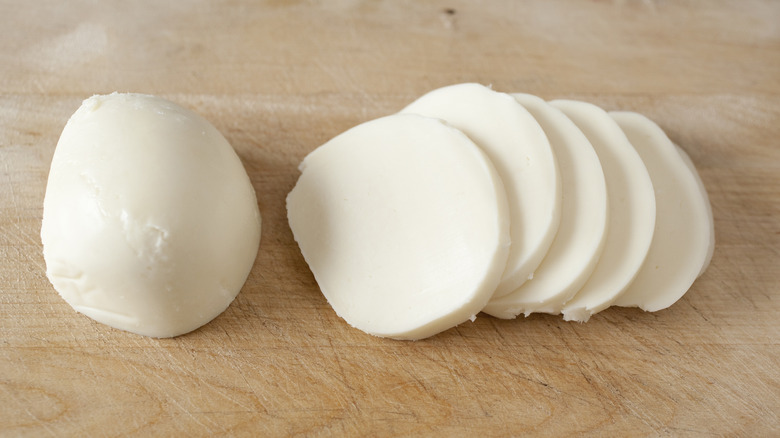12 Secret Ingredients You Should Always Use In French Toast
French toast will never let you down. This breakfast mainstay has been putting smiles on faces first thing in the morning for almost two thousand years, with an early recipe for French toast (without the name we know it by these days) appearing in an ancient Roman cookbook. Over the years, the breakfast treat then made its way to America in the hands of French immigrants, and its modern name was born.
In its most basic form, French toast is simple: A dish consisting of bread that's been dipped in a combination of eggs and milk, and fried on each side until golden brown. But anyone who's tried French toast will know that's not all there is to it. This dish — which can be made sweet or savory — truly pops when it's made more exciting with the addition of other ingredients.
While a simple French toast might just have some sugar in its batter or a few berries sprinkled on top, true toast aficionados know that there are some secret ingredients that can make the meal sing. We decided that we were sick of keeping them to ourselves — so we put them all together here, for you.
1. Vanilla extract
Sometimes, the most simple secret ingredients are also the best. Vanilla extract is such an ingredient. It's also a surefire way to amplify French toast, giving the whole dish a floral, warming quality that practically begs to be eaten. It's easy to forget sometimes that vanilla is a spice — with a complexity that its reputation doesn't quite acknowledge all the time. It works best in sweet dishes like French toast, where its inherent creaminess makes it a perfect pairing for the eggs and milk custard used in the dish.
Adding vanilla extract to French toast is simple: Just put a dash or two in your custard while you're whipping it, before dipping your toast in. Vanilla is a key component in French toast dishes that are often considered the most authentically French: a recipe called "pain perdu." Instead of using classic white slices, pain perdu instead opts for day-old pieces of brioche or French baguette sliced into rounds. The custard, meanwhile, is made even thicker and more luxurious by the addition of cream, and then a dash of vanilla extract reinforces the flavors in the dish even further. The whole affair is then fried and served with your choice of toppings.
2. Cornstarch
One common problem when it comes to making French toast is the consistency of the custard. Add too much milk, and your custard will be thin and watery — not only moistening your bread too much but also adding too much moisture to the pan, causing the mixture to boil instead of fry. To remedy this, you can add more eggs to balance out the custard, as well as add a thickening agent like cornstarch. While cornstarch may not change the thickness of your custard too much when cold, once it's heated, it will help to create a firm, chewy coating for your French toast.
Coating foods with cornstarch also allows them to brown beautifully when fried, giving your French toast more of a golden coloring and increased visual appeal. Where cornstarch really shines, though, is in making eggless French toast. The starch essentially replaces eggs as a thickening and binding agent — which is ideal for folks who are allergic to or avoiding the protein. An entirely dairy-free French toast can also be made by using a combination of cornstarch and non-dairy milk, such as almond or oat milk.
3. Rum
You might not be used to having rum at breakfast, but once you've added it to French toast, you'll never look back. Rum is a quick and innovative way to add a depth of flavor to your custard. If you use dark rum, you can add particularly intense notes and scents. Thanks to its aging process — which occurs in wooden barrels or casks – dark rum develops a smoky, caramel-infused flavor, with a spicy undertone. This makes it the perfect addition to sweet French toast recipes, where it can counteract sharper, sweeter tastes.
Remember that it's best to use rum sparingly in your French toast. "When you cook with rum, it ultimately serves you well as an accentuating element, not necessarily the focal point," Kaya chef and co-owner Nigel Jones told Liquor.com. It's best combined with other spices like vanilla and cinnamon. Simply add a few drops of the liquor to bolster everything.
The alcohol in rum also serves to boost the aroma of your food. Interaction with the fat molecules in the eggs and milk will make everything taste richer and, ultimately, better. Just be sure not to add too much. While a few drops will make your breakfast taste better, adding a full shot of rum will not just water down the custard, but overpower the dish with the acrid taste of alcohol. If not cooked enough, it may even end up making you drunk.
4. Ground cinnamon
Of all the spices that work with sweet foods, cinnamon is one of the best. While it's used in both savory and sweet applications, it's the latter that we prefer. There are lots of different types of cinnamon, but when it comes to French toast, ground cinnamon is the way to go. Ground cinnamon brings a slight warmth to the dish, with an earthy, woody taste that counterbalances the richer dairy components well. The fragrance of the spice also accentuates the toast, filling your home with a comforting scent and making it smell like the holidays.
Make sure you're using ground cinnamon sparingly in your custard, as too much will overpower the dish and make it too spicy. You should also ensure that you whisk your cinnamon in really well. Like other ground spices, ground cinnamon has a tendency to clump up when added to a liquid, so whisking allows you to distribute it evenly. If you'd prefer to have your cinnamon on top of your French toast instead of inside it, you can also whip up a quick cinnamon sugar, by combining granulated sugar and ground cinnamon and then sprinkling it on before serving.
5. Ice cream
We're of the firm opinion that adding ice cream to anything is a good idea. Apparently, celebrity chef Jacques Pépin agrees — at least in the case of French toast. Pépin uses melted ice cream to create next-level French toast. It's a quick and easy way to give your toast added richness and sweetness, and use up any leftover ice cream taking up space in the freezer.
Pépin's method is simple: All he does is take some melted ice cream and soak his bread in it for a few minutes, flipping it periodically. The ice cream takes the place of the custard you'd normally make. It also has the added benefit of already being sweetened, meaning you don't have to worry about any additional sugar. Pépin then takes things up a notch further, by serving the finished French toast with the extra melted ice cream, which serves as a kind of dipping sauce.
While Pépin uses vanilla ice cream (which also eliminates the need to use vanilla extract), you can use pretty much any flavor you'd like. Just make sure that you're using toppings that match your chosen cream: Try using chocolate chips for chocolate-soaked French toast, for example, or fresh berries for a strawberry ice cream-infused meal.
6. Salt
To make things a little sweeter, sometimes you need a totally different taste. That's where salt comes in. Adding salt to sweet French toast recipes is an awesome way to bring out the sweetness of a dish, thanks to its ability to boost your ability to taste sweetness when present in lower quantities. At this level, it can also reduce bitterness, and increase umami and sour flavors.
Salt is also a must if you're making savory French toast, where it works to heighten the umami flavors in the dish you're making. Whatever flavors you're working with, though, make sure that you're using it sparingly. If you use too much salt in a sweet dish, it will work against the sugar. If you use too much salt in a savory dish, it will completely overpower any subtlety in your flavors. Too much salt could also leave you grasping for water after your meal.
7. Nutmeg
Along with cinnamon, nutmeg is one of the quintessential holiday spices. But for some reason, it tends to be used way less than its fellow, woody-scented cousin. We thoroughly recommend giving it a try with French toast, though.
Like cinnamon, nutmeg has an earthy flavor and scent, with an undertone of sweetness that makes it an ideal pairing for the sugar and dairy in the dish. But it also has a mellow nuttiness to it, which gives meals depth in a different way to cinnamon's slightly floral notes.
Nutmeg is available in both whole and ground form — and either can be used for French toast. If you're buying whole nutmeg, you'll need to grate it directly into your custard before mixing it in thoroughly. Be sure to use less than you think: Fresh nutmeg is particularly potent and will have a much stronger flavor than if you're using the ground form. Ground nutmeg is slightly weaker, but you still won't want to use too much of it.
Remember that the flavor will intensify as it heats, too. Using too much nutmeg can result in your food having a bitter, soapy taste, but this can be counteracted before cooking, by adding more milk or eggs to your custard.
8. Bourbon
Bourbon is an excellent secret ingredient for French toast, thanks to the immediate layers of flavor it delivers. The main benefit of using bourbon in French toast is the smoky flavor that whiskey possesses, thanks to its aging in charred oak barrels. As it's made predominantly from corn, bourbon is also noticeably sweet, making it a good alcohol choice for French toast. This type of liquor also has the capacity to accentuate other ingredients in the dish. "Bourbon will enhance notes of vanilla and caramel, complement nuttiness, and add hints of toasted oak," food writer Lori Rice told Alcohol Professor.
When choosing a bourbon, be prepared to spend a good amount of money on it. Cheaper choices will taste too heavily of pure alcohol, and won't have any of the subtleties of flavor that you can expect from a pricier product. You don't have to break the bank, though: The top-shelf stuff is definitely best drunk on its own, as you'll lose some of its nuances when it's added to the toast custard.
9. Banana
Bananas and French toast is a timeless pairing, so you might be wondering what's so special about this ingredient recommendation. Well, our trick is not to put the banana on top, but inside the toast itself. By blending a ripe banana with eggs, you can make a thick batter to coat your bread in. This batter fries incredibly well, with both the banana and the egg working as a binder. Thanks to the natural sugars in the banana, there's no need to add any additional sugar, as the whole dish will be given a subtly sweet edge without tasting too harsh or artificial.
Using bananas as a secret ingredient is a great hack for people who are lactose intolerant, thanks to the removal of the milk. You're also able to sneak in all of the vitamins and minerals present in bananas. According to the Harvard School of Public Health, these include potassium, magnesium, and vitamin C. To stop your French toast from tasting too one-note, add in some additional spices like vanilla or cinnamon. Remember that using a banana that's not ripe enough may result in your toast batter being a little chalky and dense, and using an over-ripe banana will make it way too mushy. Aim for a banana that is in the middle ground.
10. Heavy cream
If you want to make your French toast totally indulgent, heavy cream is the way to go. Heavy cream can work in the same way milk does in a French toast custard, but thanks to its way-higher fat content and thickness, it'll add a velvety texture to it, that will translate to the taste. How much heavy cream you use is entirely up to you, and how rich you want the end result to be. If you're using it as a substitute for whole milk, try thinning it out with a little bit of water. If, on the other hand, you want to make a meal that's heavier in fat, keep it undiluted.
Heavy cream can also be added at the end of a French toast recipe, drizzling it over the finished product to add extra moisture to the dish. And remember, too, that heavy cream can be made into stiff whipped cream easily. Just put it in an electric mixer and whip it up. You can then add flavorings to the cream, like vanilla extract or coffee, for a breakfast that'll perk your guests up.
11. Frosted Flakes
A lot of French toast's appeal lies in its contrast of softness and crispiness, achieved by frying the coating to golden-brown perfection, leaving the insides pillowy. You can make this contrast even more pronounced, however, by adding a further coating of Frosted Flakes. This secret ingredient is beloved by none other than Kylie Jenner, and was shared with her by her sister Khloé Kardashian, according to Today. After dipping your bread in the standard egg and milk custard, you then coat the wet pieces in crushed Frosted Flakes, before frying them.
The Frosted Flakes don't just add crunch and texture to the toast: They also amp up its sugar content, making the whole dish even sweeter. When fried, Frosted Flakes caramelize gently, and the ridged texture you gain from the crushed pieces gives the toast extra crispiness. Just make sure that you're frying your toast relatively quickly after dipping it in the crushed flakes. The longer you leave it, the more that the custard will soak into the frosted pieces, potentially making them soggy and ruining the overall effect. You should also make sure that you're using enough butter or oil when you fry the pieces, as the flakes will soak up all of the fat, leaving it vulnerable to sticking to the pan.
12. Mozzarella
A lot of emphasis is placed on sweet French toast recipes, but you shouldn't forget about the savory ones too. French toast, in its pure form, has an essentially neutral flavor, with the eggs and milk lending themselves to savory tastes just as well as sweet ones. Generally, savory French toast excels with toppings like bacon or sausages, with the sharp, salty, meaty flavors contrasting the dairy fats. But stuffed savory French toast, using mozzarella is a great way to double down on those dairy flavors and give your toast an unparalleled chew.
You simply have to seal a slice of mozzarella between two slices of bread, using a fork around the edges to push the carbohydrates together (removing the crust makes this easier), before coating as normal with custard, then frying. The mozzarella will then melt as the toast cooks, thanks to its high moisture content. When you cut it open, the cheese will be gooey and rich. It's best to pair this dish with a contrasting sauce — one which has sharp, vinegary notes — to stop the whole meal from being way too cloying. Hot sauces or a sweet chili dipping sauce will work well here, with the spice in each adding a completely new taste element.
